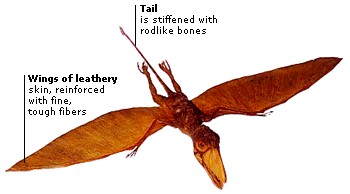DK Nature: Dinosaurs
This group of land-living reptiles appeared around 230 million years ago. Like reptiles today, dinosaurs had a scaly, waterproof skin, and young that hatched from eggs. For 165 million years, a period called the Mesozoic era, they dominated life on Earth. They suddenly became extinct 65 million years ago (mya).
The large size of many plant-eating dinosaurs helped protect them from fearsome meat-eaters. This led to the evolution of larger predators, big enough to tackle their prey, which in turn resulted in an increase in the size of plant-eaters. Over millions of years, both prey and predator grew bigger and bigger.
Dinosaurs fall into two groups. The ornithischian dinosaurs were all plant-eaters, but the saurischian dinosaurs included plant-eaters and meat-eaters. Other reptiles that lived at this time, but were not actually dinosaurs, included flying reptiles called PTEROSAURS, and marine reptiles such as ICHTHYOSAURS and plesiosaurs.
Dinosaurs stood upright on straight legs. Their legs were directly under them, so their bodies were always raised off the ground. This allowed them to grow bigger and let them move faster. Reptiles today have a sprawling stance, with legs held out to the sides. Their bodies are close to or resting on the ground. This limits their size and their ability to move.
Pterosaurs belong to the same group of reptiles as dinosaurs and are closely related. The largest, Pteranodon, had a wingspan of up to 30 ft (9 m).
Birds and pterosaurs evolved separately. Similarities in skeletons show that birds evolved from saurischian dinosaurs. But birds and pterosaurs have similar features, including a streamlined shape, wings, hollow bones, and a lightweight beak. A furry body suggests that, like birds, pterosaurs were warm-blooded. Unrelated living things sometimes develop similar features to suit similar lifestyles.
These reptiles spent their lives in the sea, surfacing to breathe. Ichthyosaurs, or “fish lizards,” gave birth to live young and fed on fish, squid, and ammonites. The largest was up to 50 ft (15 m) long.
Life beneath the ocean looked much as it does today. The seas teemed with animals such as sharks, starfish, corals, whelks, jellyfish, and lobsters. However, swimming alongside them were huge and now-extinct marine reptiles, such as plesiosaurs and ichthyosaurs.

